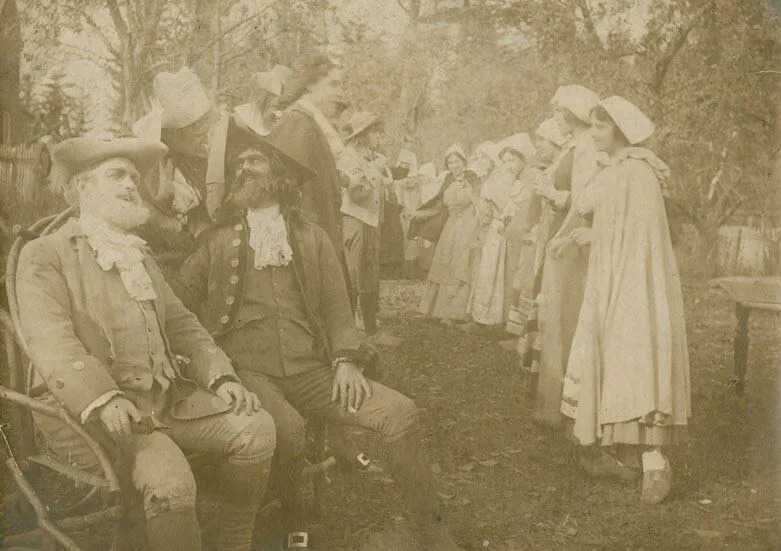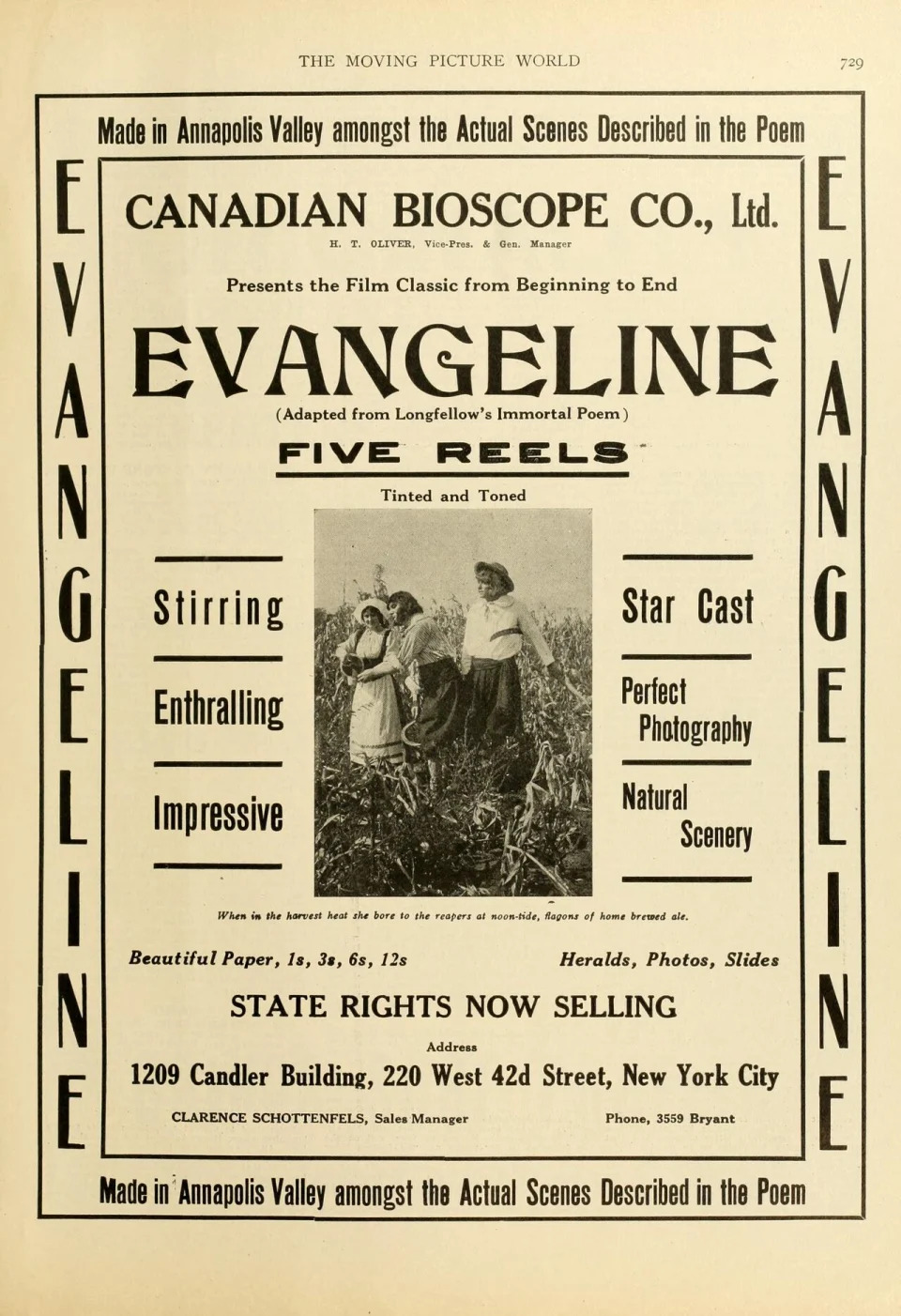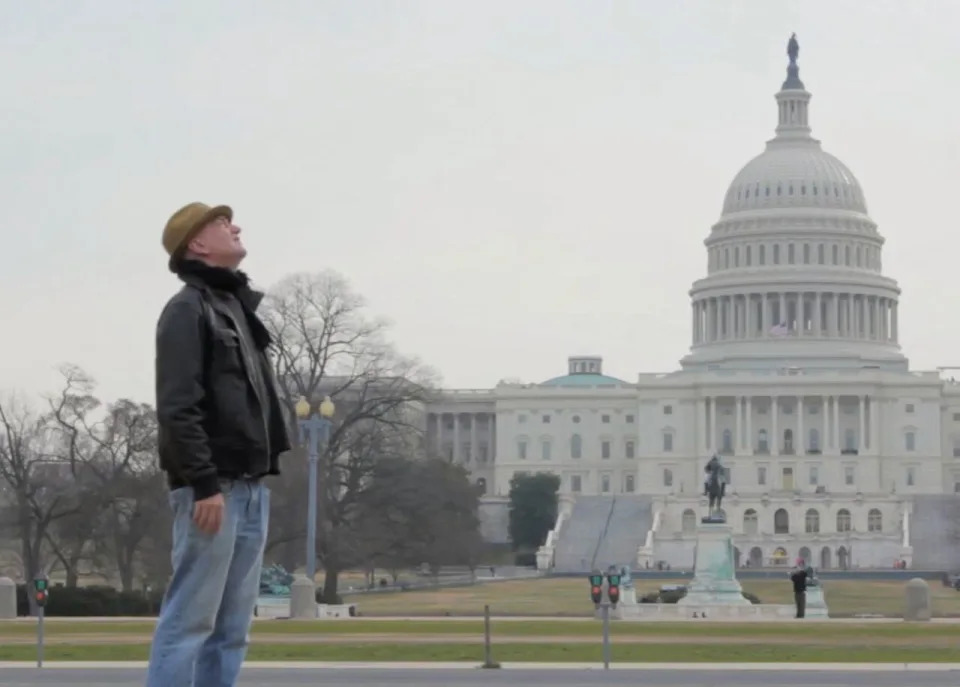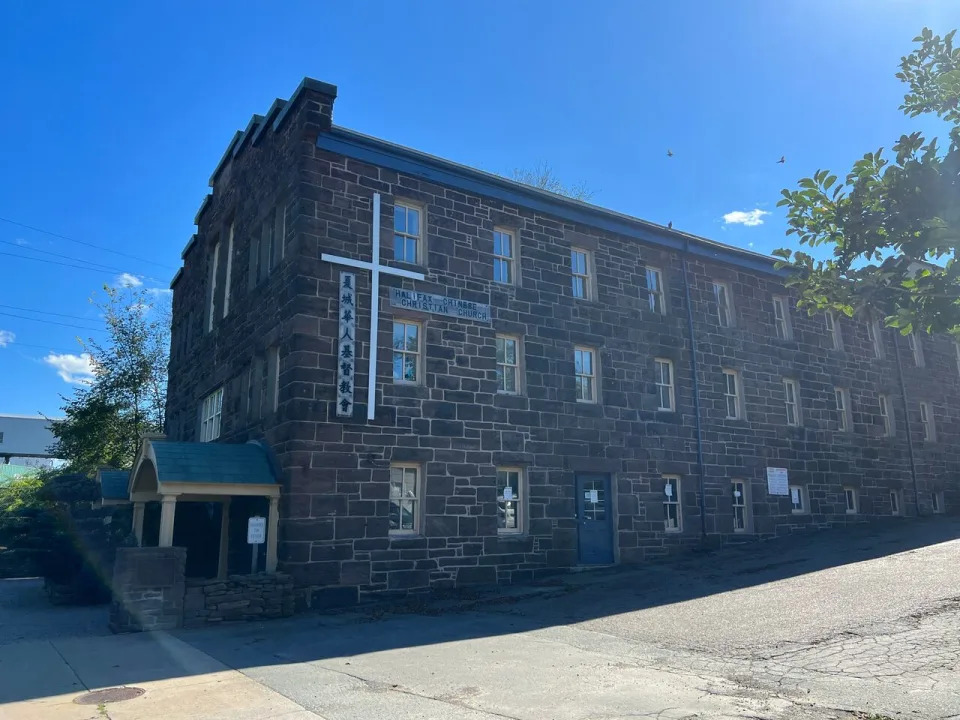CBC
Sun, September 24, 2023

This scene from Evangeline was filmed in Halifax at the garden of the Billman residence, which would be located on present-day Herring Cove Road near the Armdale roundabout.
(James Billman Collection, Nova Scotia Archives 1981-295 no. 1. - image credit)
After travelling to about 30 states and a half-dozen provinces looking for a copy of Evangeline, one of Canada's first feature films, Bashar Shbib came up empty handed.
Shot in 1913 in Nova Scotia and Quebec, Evangeline is based on American Henry Wadsworth Longfellow's epic poem, Evangeline: A Tale of Acadie. It tells the story of Evangeline and Gabriel, two star-crossed lovers from Grand Pré, N.S., torn apart by the Expulsion of the Acadians beginning in 1775.
There are no known copies of Evangeline. The proof of its existence lies in clues from a few surviving images, journalism of the day and a description of the film housed with the U.S. Library of Congress in Washington.
"The idea that the film has disappeared is definitely sad," said Shbib, a Montreal-based filmmaker who made a documentary about his efforts to find a copy of Evangeline. Fittingly, the 2013 documentary is titled The Search For Evangeline.
Evangeline is considered Canada's first feature film because it was made by a Canadian company, the Canadian Bioscope Company, which was headquartered in Halifax.

This ad for Evangeline appeared in the Feb. 7, 1914, edition of The Moving Picture World magazine.

Another scene from Evangeline shot at the Billman residence in Halifax. Fewer than 10 photos showing scenes from the film are known to exist.

Bashar Shbib's efforts to locate Evangeline took him to cities across North America, including Washington, D.C. (Oneira Pictures)
"In those days, you copyright the film by taking the image of the first of every shot [in the film]," said Shbib.
The film's description notes it had 200 scenes.
But to Shbib's dismay, he said he was told they had recently thrown the images out.
Why copies weren't kept of old films
George Melnyk, the author of One Hundred Years of Canadian Cinema, said it's not surprising no known copies of Evangeline exist because that's common for most films of the time.
"Nobody thought of them as having longevity or archival value or meaning for the cultural history of a particular country," he said. "Companies, you know, disappeared. The films went in the trash or whatever happened to them, things like that, because they simply weren't seen as valuable cultural documents."

The Canadian Bioscope Company, which made Evangeline, was headquartered in Halifax on what is now present-day Barrington Street near Inglis Street. (Mark Crosby/CBC)
The Canadian Bioscope Company went out of business when the First World War broke out, says the Nova Scotia Archives' website.
While Nova Scotia now has a booming film and television industry, Evangeline is a reminder of its early days.
"There should be more research and more studies into what's missing," said Shbib. "What are the films that we're not talking about and what are the stories ... that have been overlooked?"
After travelling to about 30 states and a half-dozen provinces looking for a copy of Evangeline, one of Canada's first feature films, Bashar Shbib came up empty handed.
Shot in 1913 in Nova Scotia and Quebec, Evangeline is based on American Henry Wadsworth Longfellow's epic poem, Evangeline: A Tale of Acadie. It tells the story of Evangeline and Gabriel, two star-crossed lovers from Grand Pré, N.S., torn apart by the Expulsion of the Acadians beginning in 1775.
There are no known copies of Evangeline. The proof of its existence lies in clues from a few surviving images, journalism of the day and a description of the film housed with the U.S. Library of Congress in Washington.
"The idea that the film has disappeared is definitely sad," said Shbib, a Montreal-based filmmaker who made a documentary about his efforts to find a copy of Evangeline. Fittingly, the 2013 documentary is titled The Search For Evangeline.
Evangeline is considered Canada's first feature film because it was made by a Canadian company, the Canadian Bioscope Company, which was headquartered in Halifax.

This ad for Evangeline appeared in the Feb. 7, 1914, edition of The Moving Picture World magazine.
(Canadian Bioscope Company, Public Domain via Wikimedia Commons)
However, it wasn't necessarily the first feature film shot in Canada.
Shot for $30,000, Evangeline used American actors for its leading roles. In Nova Scotia, shooting locations included Halifax and the Annapolis Valley, duly noted in an ad for the film declaring it was "Made in Annapolis Valley amongst the Actual Scenes Described in the Poem."
Annapolis Royal mayor was 'moved to tears' by film
The film description housed at the Library of Congress echoes this as well and includes a signed reference letter, of sorts.
"I can certify having witnessed the churchyard scenes, played and filmed in the old graves yard there, being moved to tears by the realistic acting of women and children," notes a letter signed by three people, including the mayor of Annapolis Royal, Geo. J. Hawkesworth.
The document also describes what happens during each of the 75-minute film's five reels.
However, it wasn't necessarily the first feature film shot in Canada.
Shot for $30,000, Evangeline used American actors for its leading roles. In Nova Scotia, shooting locations included Halifax and the Annapolis Valley, duly noted in an ad for the film declaring it was "Made in Annapolis Valley amongst the Actual Scenes Described in the Poem."
Annapolis Royal mayor was 'moved to tears' by film
The film description housed at the Library of Congress echoes this as well and includes a signed reference letter, of sorts.
"I can certify having witnessed the churchyard scenes, played and filmed in the old graves yard there, being moved to tears by the realistic acting of women and children," notes a letter signed by three people, including the mayor of Annapolis Royal, Geo. J. Hawkesworth.
The document also describes what happens during each of the 75-minute film's five reels.

Another scene from Evangeline shot at the Billman residence in Halifax. Fewer than 10 photos showing scenes from the film are known to exist.
(James Billman Collection, Nova Scotia Archives 1981-295 no. 2)
While Evangeline was made by a Canadian company, it was distributed out of New York and released in 1914.
Film trade publication The Moving Picture World predicted Evangeline would be a "a strong favourite everywhere as the subject is well known to ... school children in the country, the study of Longfellow's classic poem being a part of the regular school work in nearly every city of the United States."
A 'soul-stirring love story'
Rival publication Motion Picture News echoed that.
"There are few Americans who do not know the pathetic and soul-stirring love story which Longfellow so plaintively poured into the poem Evangeline. Consequently, the picture should attract unusual and wide-spread attention," it said.
In a separate issue, Motion Picture News noted that a matinee was arranged in Buffalo, N.Y., for pupils of School No. 26 to see Evangeline.
"The pupils are studying this literary classic in their English courses and all were enthusiastic about the matinee," it said.
Where Evangeline screened
The film was screened in cities including New York, Philadelphia, Chicago, Boston, Montreal, Toronto and Halifax, and received glowing reviews.
Shbib's search for Evangeline saw him track down descendents of people who worked on the film in the hopes they had a copy. He even went to the Library of Congress.
While Evangeline was made by a Canadian company, it was distributed out of New York and released in 1914.
Film trade publication The Moving Picture World predicted Evangeline would be a "a strong favourite everywhere as the subject is well known to ... school children in the country, the study of Longfellow's classic poem being a part of the regular school work in nearly every city of the United States."
A 'soul-stirring love story'
Rival publication Motion Picture News echoed that.
"There are few Americans who do not know the pathetic and soul-stirring love story which Longfellow so plaintively poured into the poem Evangeline. Consequently, the picture should attract unusual and wide-spread attention," it said.
In a separate issue, Motion Picture News noted that a matinee was arranged in Buffalo, N.Y., for pupils of School No. 26 to see Evangeline.
"The pupils are studying this literary classic in their English courses and all were enthusiastic about the matinee," it said.
Where Evangeline screened
The film was screened in cities including New York, Philadelphia, Chicago, Boston, Montreal, Toronto and Halifax, and received glowing reviews.
Shbib's search for Evangeline saw him track down descendents of people who worked on the film in the hopes they had a copy. He even went to the Library of Congress.

Bashar Shbib's efforts to locate Evangeline took him to cities across North America, including Washington, D.C. (Oneira Pictures)
"In those days, you copyright the film by taking the image of the first of every shot [in the film]," said Shbib.
The film's description notes it had 200 scenes.
But to Shbib's dismay, he said he was told they had recently thrown the images out.
Why copies weren't kept of old films
George Melnyk, the author of One Hundred Years of Canadian Cinema, said it's not surprising no known copies of Evangeline exist because that's common for most films of the time.
"Nobody thought of them as having longevity or archival value or meaning for the cultural history of a particular country," he said. "Companies, you know, disappeared. The films went in the trash or whatever happened to them, things like that, because they simply weren't seen as valuable cultural documents."

The Canadian Bioscope Company, which made Evangeline, was headquartered in Halifax on what is now present-day Barrington Street near Inglis Street. (Mark Crosby/CBC)
The Canadian Bioscope Company went out of business when the First World War broke out, says the Nova Scotia Archives' website.
While Nova Scotia now has a booming film and television industry, Evangeline is a reminder of its early days.
"There should be more research and more studies into what's missing," said Shbib. "What are the films that we're not talking about and what are the stories ... that have been overlooked?"
No comments:
Post a Comment